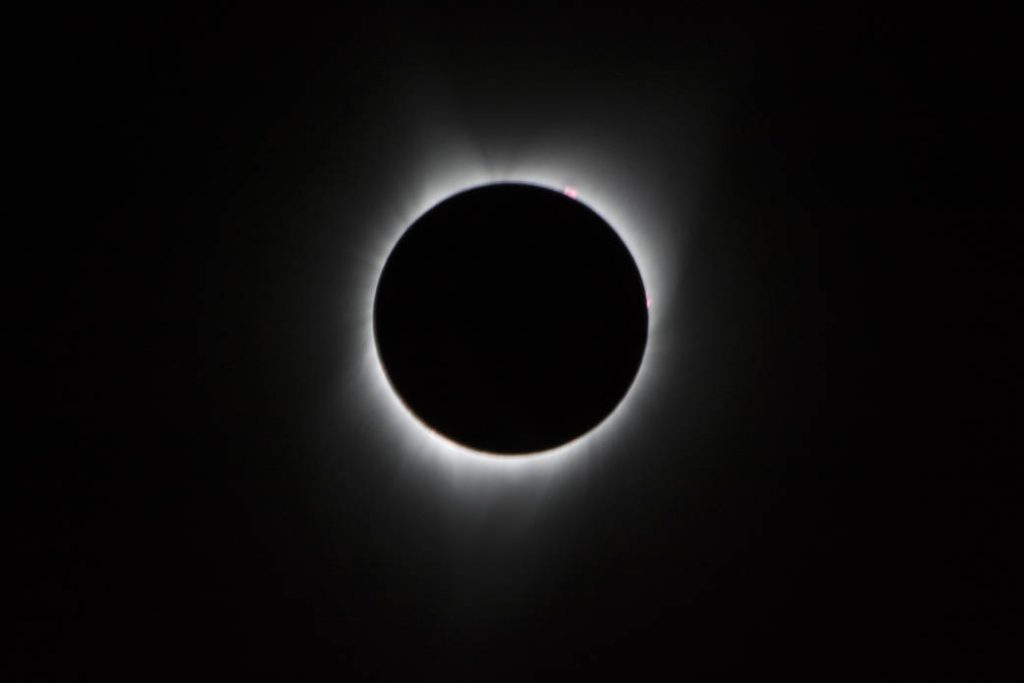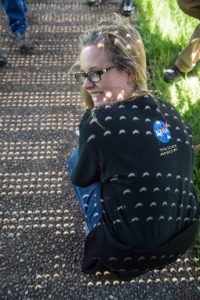by Lauren Lambert
What is a Solar Eclipse?
A solar eclipse is a natural phenomenon that occurs when the Moon passes between the Sun and Earth. This event happens when the Moon completely blocks the Sun and the Moon’s shadow falls onto a portion of the Earth’s surface.
There are three types of solar eclipses: total, partial and annular. During a total solar eclipse, observers can witness daytime twilight because the disk of the Moon blocks 100% of the Sun. During a partial solar eclipse, the Moon is not entirely covering the Sun and you will likely not notice any difference in light intensity. You may only notice a subtle difference if the partial eclipse is close to total and you go outside at maximum eclipse. Lastly, an annular eclipse can be observed when the Moon is at apogee, or the farthest from Earth within its elliptical orbit. This causes a ring of light, or annulus, to be visible around the Moon, which is sometimes referred to as the “ring of fire.”

Total eclipses are of particular interest to solar scientists, because with the Moon blocking the bright light of the Sun, you can see the Sun’s atmosphere from the ground. Solar scientists at Marshall Space Flight Center, and around NASA, make use of telescopes called coronagraphs that block the Sun so they can see the dim atmosphere, the corona, around it. But — given how perfectly the Moon lines up with the Sun — you can see the atmosphere closer to the surface of the Sun than we even can with our telescopes in space.
The shadow of the Moon on a planet during an eclipse can be described using three terms: umbra, antumbra and penumbra. The umbra is the shadow that is cast when the Moon completely covers the Sun and is where the path of totality falls. If the Moon is further away from the Earth, it is unable to block the Sun entirely. The Sun appears as a ring of light around the Moon. In this case, the shadow is known as the antumbra, or path of annularity, and occurs during an annular eclipse. Similarly, a partial solar eclipse can be observed when only a portion of the Moon blocks the Sun and creates a shadow referred to as the penumbra. The penumbra also occurs surrounding the umbra during a total eclipse, effectively covering those regions on the planet that only have a view of a partial eclipse.

Solar eclipses happen at least twice per calendar year, with total solar eclipses occurring about once every year and a half. But the possibility of seeing them is rare if you’re not in the right place at the right time. Additionally, since Earth is made up of mostly water, the path of totality, or the area receiving total blockage of the Sun, may not necessarily fall on land.
The year of 2020 sees two solar eclipses. The first occurred on June 21 and was an annular solar eclipse, visible from the continents of Africa and Asia. The second will be a total solar eclipse, occurring on Dec. 14, visible from South America. The path of totality crosses over Chile and Argentina, but some of their areas outside of the path of totality will experience a partial solar eclipse. The total eclipse will also be visible in Antarctica, South Africa, as well as the Pacific, Atlantic, and Indian Oceans. Observers will be able to witness the total solar eclipse for about 2 minutes.
If you are not within the path of totality, watching the total solar eclipse from a virtual location is an option as well. You can view it on NASA TV and the agency’s website, beginning at 10:30 a.m. EST on Dec. 14. Be sure to check it out, as the next total solar eclipse won’t be happening until Dec. 4, 2021.
Top 5 Solar Eclipse Viewing Tips:
- Do not stare directly at the Sun. Wear safety approved, protective solar eclipse-viewing glasses to directly view the event or use some indirect means (see below). For more information here are some NASA Safety tips.
- To indirectly view the eclipse, create a pinhole camera or box projector. Learn how to build your own here.
- Stand under a tree and look at the ground. The trees act as pinhole projectors and will project hundreds of crescent shapes right at your feet.
- To capture an eclipse with binoculars, a telescope, or a camera, you must use a safety-approved, protective solar filter on your lens.
- Keeping with the theme of 2020 – Observe the eclipse virtually! It will be streamed live here.
